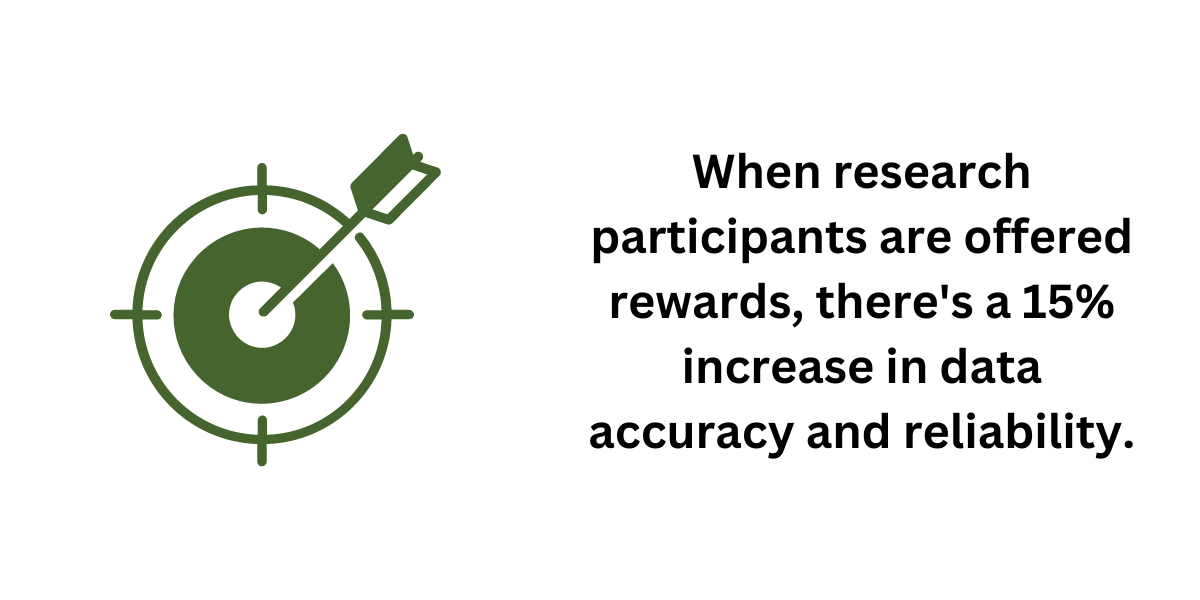Academic Research Incentives: How, Where And When Does It Work?


by Signe Hegart
August 28, 2023
As universities and colleges keep on pushing and supporting academic research, the idea of research rewards becomes more and more crucial. Academic research incentives are rewards, awards or benefits given to researchers to appreciate and inspire them for their important work and writings in the academic world. ????
This blog post will dive into different sides of these rewards, looking at why they’re good, the problems they might bring, and the special answers that Huuray has, both locally and globally????. Lastly, we will dive into who can get these rewards for their academic research and how they help make teamwork and research collaboration better.
Jump to
What are academic research incentives?
Academic research incentives refer to rewards, benefits, or compensations offered to individuals participating in research studies conducted by academic institutions. These incentives are designed to motivate participants to engage in the research process, provide accurate and valuable data, and contribute to the study’s objectives. Academic research incentives can take various forms, including monetary rewards, gift cards, vouchers, access to exclusive content, certificates, or other tangible and intangible benefits. The goal of offering incentives is to enhance participant recruitment, engagement, and data quality, ultimately leading to more robust and meaningful research outcomes.

Benefits of academic research incentives
Research incentives offer a multitude of benefits to both researchers and institutions. For researchers, these incentives provide recognition for their hard work and dedication. They also serve as a motivation to continue producing high-quality research. Moreover, incentives can enhance researchers’ professional growth and reputation within the academic community.
For institutions, providing research incentives helps attract and retain talented researchers. It also promotes a culture of innovation and excellence, which ultimately enhances the institution’s reputation and competitiveness. By supporting research incentives, universities and colleges can demonstrate their commitment to academic excellence and contribute to the advancement of knowledge in various fields.
Academic research incentives can help:
- Attract really good and committed people to take part
- Get people who are usually hard to reach or always moving around
- Include a diverse and meaningful group of people in the study
- Make sure participants feel fairly rewarded for their time, knowledge, opinions, or feedback
- Deal with worries or concerns people might have about joining a research study, like taking up too much time or sharing personal info
- Make participants feel more involved and interested in the study
Related: Optimizing UX Research Incentives: 4 Essential Steps
Overcoming challenges in academic research incentives: Unlocking solutions with Huuray
However, despite the numerous benefits, there are challenges that researchers face when it comes to receiving and utilizing research incentives.
- One of the most common problems is the limited options available for participations to choose from. Traditional incentives such as cash rewards or certificates may not resonate with all researchers, and the lack of flexibility can diminish their motivation and performance.
- Perverse incentives in academic research can also be a struggle which refer to situations where the offered rewards or incentives unintentionally lead to behaviors that undermine the integrity, quality, or ethical standards of the research process. While incentives are intended to enhance engagement and data collection, they can sometimes result in unintended consequences that negatively impact the research outcomes. Examples of this can mean distracted focus were participants focus more on obtaining the reward rather than genuinely engaging in the research process. This can result in hurried or careless responses that don’t accurately reflect their actual opinions or behaviors.
- In some extreme cases, the human subjects might provide false or fabricated data to meet the criteria for receiving incentives. This compromises the reliability and accuracy of the research findings.
Additionally, the administrative burden of managing and distributing incentives can be time-consuming and inefficient for institutions. But don’t worry, Huuray have the solution for it! ????????
Huuray’s solution for optimal Academic Research Incentives
Let Huuray help you optimize both your time and incentives for the participants.
With Huuray you can globally and locally choose gift cards, prepaid cards and donations after what you participants prefer.
At Huuray you will have the opportunity to create your own gift card after your own wishes, it may be with a school logo, a small personal message or even both.
You have +5000 rewards and gifts globally, the opportunity to send to anyone, anywhere in the world 24/7. With Hurray’s easy systems, you will receive your chosen academic research incentives with only a few clicks.

Send yourself a Academic Research Incentives
Want to see how a academic research gift card looks like without any commitment? Now you can send yourself a sample to see how it would arrive. It takes one click to see it all. It has never been easier
Select from a variety of incentives globally
Once you have identified participant motivations, it’s time to design your incentive strategy. Consider the following to optimize the effectiveness of your incentives:
But what does it mean to set goals for UX research incentives and what is the most popular method?
UX research incentives can be tracked and measured for success by implementing a few key strategies. Here are some steps you can take to effectively track and measure the success of your UX research incentives:
We got you covered!
We have digital reward options in +100 countries around the world. Gift Cards, PrePaid Cards, Charities and much more. Sending rewards internationally is a breeze with Huuray. All for free
Prepaid visa cards
Prepaid visa cards are similar to gift cards, but they often come with a wider range of usability, allowing recipients to use them like debit cards. They can be particularly effective for incentivizing larger behaviors, like participating in a study or program over a longer period. Prepaid cards offer flexibility and can appeal to a broader audience.
This global acceptance is a key feature that makes these cards a favored choice for travelers, online shoppers, and individuals seeking a versatile payment solution. Here’s how you can use prepaid Visa cards across the globe:

Global network
Visa is one of the most widely recognized and accepted payment networks worldwide. Prepaid Visa cards leverage this extensive network, allowing you to make purchases and transactions in a multitude of countries, spanning diverse cultures and economies. At Huuray we offer +100 countries you can choose from.

Retail stores
Whether you’re exploring local markets, luxury boutiques, or department stores in foreign lands, prepaid Visa cards enable seamless transactions at retail points of sale. Simply present your card, and if Visa is accepted, you can make purchases without the hassle of currency exchange.

Online shopping
The digital age has revolutionized commerce, and prepaid Visa cards play a crucial role in this evolution. They can be used to shop on international websites, subscribe to streaming services, book flights and accommodations, and much more. This means you can access products and services from around the world without leaving your home.
Related: 3 Ways Study Gift Cards Enhance Your Research Program
Gift cards
Gift cards are a popular type of incentive. They offer recipients the freedom to choose their own rewards from a variety of options. This can be particularly effective because people are more likely to engage in a desired behavior if they see a direct benefit value. Gift cards can be for specific stores, restaurants, online retailers, or even general prepaid cards that can be used anywhere major credit cards are accepted.

Depending on the merchant, gift cards can typically be redeemed both in-store and online. During purchasing, the recipient of a gift card can simply provide the actual card or give the store the card’s information; the merchant will then deduct the purchase price from the card’s balance. If their purchase is greater than the card balance, they can use another form of payment to complete the transaction:
At Huuray we are focused on making rewards accessible all over the world. We are always working on widening our catalogue, so your recipients can feel even more appreciated when using your rewards. In our portfolio, you can find a lot of different categories for gift cards, starting with Freedom of Choice, Charity/Donations, Bulk Gift Cards, Multi-Store Gift Cards, but also Country Gift Cards where you can find Sweden Gift Card, Norway Gift Card, USA Gift Card and many more to choose from.

Charity
Charity donations as incentives involve contributing to a cause or charity on behalf of the individual or group that you want to incentivize. This can create a positive social impact and align with the values of the participants. However, the effectiveness of this approach might depend on the cause or charity you choose, as well as the preferences of the recipients. Some people may find this type of incentive particularly meaningful, while others might prefer more tangible rewards.




Let’s have a chat
How do academic research incentives promote knowledge sharing?
1. Encouraging publication: Research incentives often include rewards for publishing papers in reputable journals or presenting at conferences. These rewards motivate researchers to disseminate their findings, making them accessible to a wider audience. This not only contributes to the body of knowledge but also promotes discussion and further research in the field.
2. Fostering collaboration: Incentives can also be designed to encourage researchers to collaborate with others. By offering rewards for joint research projects or interdisciplinary collaboration, institutions promote knowledge sharing across different disciplines. This interdisciplinary approach can lead to innovative solutions and breakthroughs that wouldn’t have been possible otherwise.
3. Supporting open access: Many academic institutions and funding agencies now prioritize open access publishing, which makes research findings freely available to the public. Research incentives can be used to encourage researchers to publish their work in open access journals or deposit it in institutional repositories. This helps in democratizing knowledge and making it accessible to a wider audience, including individuals without access to expensive journal subscriptions.
4. Sharing research data: Incentives can also be provided for sharing research data and making it available for reuse. By promoting data sharing, institutions facilitate collaboration, replication of studies, and the development of new
Related: Market Research Panels: Everything You Need To Know And More

Can certain incentives lead to biased responses or misrepresentation?
Certain incentives can indeed lead to biased responses or misrepresentation in research studies. This potential bias can arise from various factors related to the nature of the incentives and participants’ motivations. Here are a few ways in which this bias might occur;
Overstated Responses:
Participants might be inclined to provide more positive or favorable responses in order to please the researcher and maximize their chances of receiving the incentive. This can result in an overrepresentation of positive opinions or behaviors.
Social Desirability Bias:
Some incentives might encourage participants to present themselves in a socially desirable manner, even if their true beliefs or behaviors differ. This can lead to responses that align with perceived norms rather than actual experiences.
Monetary Gain Influence:
Monetary incentives, in particular, can lead participants to provide answers they believe align with what the researcher wants to hear in order to secure the reward. This compromises the honesty and accuracy of the responses.
By being aware of these potential biases and implementing strategies to counteract them, researchers can ensure that their study outcomes are more accurate and aligned with the genuine behaviors and opinions of participants.
Are there ethical concerns related to offering incentives, especially in sensitive research areas?
Ethical concerns can arise when offering incentives, especially in sensitive research areas. The potential to influence participants’ decisions and behaviors raises questions about the voluntariness of their involvement and the potential impact on the research’s integrity.
Coercion and undue influence can result from incentives that are overly appealing, potentially overshadowing the informed consent process. Vulnerable populations, facing challenges such as financial difficulties or health issues, might be more susceptible to the allure of incentives, leading to concerns about exploitation.
In sensitive contexts, substantial incentives could encourage participants to disclose more personal information than they would otherwise feel comfortable sharing. This jeopardizes privacy and confidentiality. Moreover, incentives might lead participants to make decisions they wouldn’t make naturally, distorting authentic responses or behaviors.
In certain cases, offering incentives might evoke emotional discomfort. Discussing traumatic experiences in exchange for rewards could be perceived as insensitive or exploitative.
Addressing these ethical concerns involves offering incentives that are meaningful yet not overly compelling. Transparency is essential; participants should clearly understand the research’s purpose and the role of incentives. Alternative options and non-monetary incentives could be provided to accommodate participants’ comfort levels.
Close attention to ethical considerations, ongoing monitoring of incentives’ impact, and seeking ethical approval from review boards or ethics committees can help ensure the well-being of participants and the integrity of the research.

What are the eligibility requirements for academic research incentives?
Academic research incentives are an essential tool for universities and colleges to encourage and reward their faculty, study teams and students for their scholarly efforts. .The eligibility requirements for academic research incentives may vary depending on the specific policies and guidelines set by each institution. However, there are some common criteria that are often considered when determining eligibility:
1. Active participation in research???????????????????? : Generally, individuals who actively engage in research activities, such as conducting experiments, analyzing data, or publishing research papers, are eligible for incentives. This includes both faculty members, junior faculty and students.
2. Meeting research milestones ✅: Institutions may set specific milestones or targets that researchers need to achieve in order to be eligible for incentives. These milestones could be related to the number of research papers published, grants secured, or patents filed.
3. Compliance with ethical guidelines ✔️: Research should be conducted in accordance with ethical standards and guidelines. Researchers must adhere to these ethical principles to be eligible for incentives.
4. Institutional affiliation ????: Typically, incentives are awarded to individuals affiliated with the institution offering the incentives. This means that faculty members and students who are part of the university or college are eligible, while external researchers may not be eligible unless there is a collaboration or partnership in place.
Conclusion
In conclusion, academic research incentives are an effective way for universities and colleges to encourage and reward their faculty, study teams, and students for their scholarly efforts. By providing incentives, institutions can increase participation in research activities, drive innovation, and enhance the overall research output.
However, it is crucial for institutions to define clear eligibility requirements for these incentives. These requirements ensure that only deserving individuals who actively participate in research, meet milestones, comply with ethical guidelines, and have institutional affiliation are eligible for incentives. This helps maintain the integrity of the research process and ensures that incentives are awarded to those who truly deserve them.
By implementing a system like Huuray, institutions can streamline the process of providing research incentives and tailor them to the preferences of the recipients. Huuray offers various options for incentives, including gift cards, prepaid cards, and donations, allowing institutions to choose the most suitable form of reward for their recipients.



Let’s have a chat
FAQ
Academic research incentives are essential because they boost participant engagement and data quality. They lead to more responses, better data, and reduced dropouts in long-term studies. Incentives also improve diversity in participants, yielding more representative results. By motivating participants, incentives enhance the reliability and applicability of research findings, especially in sensitive areas. They allocate resources effectively and ensure ethical participation. Incentives contribute to better insights, wider collaboration, and the practical application of research outcomes.
Universities and colleges play a crucial role in promoting and supporting academic research activities. One effective way to encourage faculty members to pursue research incentives is by offering a range of attractive benefits. These incentives can provide the necessary motivation and support for faculty to engage in research and contribute to the advancement of knowledge in their respective fields.
There are several benefits of research incentives for both faculty members and the institutions they work for. For faculty, research incentives can provide additional income through grants, stipends, or bonuses. These financial rewards can help cover research-related expenses, such as travel, equipment, and hiring research assistants. Moreover, research incentives can enhance a faculty member’s reputation and career prospects by showcasing their expertise and contributions to the academic community.
For universities and colleges, research incentives can yield numerous advantages. First and foremost, research incentives can attract and retain top-quality faculty members. By offering attractive research incentives, institutions can lure talented researchers who are seeking a supportive and rewarding environment for their research endeavors. This, in turn, enhances the institution’s reputation and competitiveness.
Academic research incentives can come in various forms, depending on the goals and preferences of the sponsoring institution. These incentives are designed to motivate and reward researchers for their contributions to the field. Here are some common types of academic research incentives:
1. Monetary Incentives: These include cash rewards, research grants, scholarships, and fellowships. Monetary incentives provide researchers with financial support to cover expenses related to their research, such as equipment, materials, and travel.
2. Recognition and Awards: Institutions often offer recognition and awards to researchers who have made significant contributions to their field. These can include certificates, plaques, trophies, or even prestigious titles. Recognition and awards not only acknowledge the researchers’ hard work but also enhance their professional reputation and credibility.
3. Research Facilities and Resources: Providing access to state-of-the-art research facilities, laboratories, libraries, and other resources can be an attractive incentive for researchers. Access to these resources can greatly enhance the quality and scope of their research, allowing them to make more significant contributions to their field.